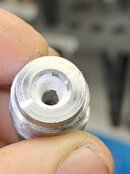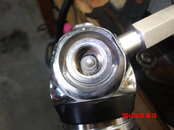[...]
Alumaprep33 will dissolve all the white oxide and stop at clean aluminum. Dump out the acid wash and rinse well with clean water. Use a cut off garden hose and hang the tank upside down to rinse. After it’s rinsed check it to see if all the oxide is gone. Repeat if necessary, you can’t overdo it.
[...]
I'm not entirely sure that this is the best way to go, for a few very specific reasons. The main ingredients in Aluminaprep33, according to Henkel, are:
- 10% to 30% Phosphoric acid as an active ingredient.
- 10% to 30% 2-Butoxyethanol as a surfactant.
Phosphoric acid is caustic to aluminum. There are acids with a higher dissolution rate of aluminum like hydrochloric or sulfuric acids, but phosphoric acid nevertheless dissolves aluminum at a substantial rate. It by no means only removes the white powdery aluminum oxide Al
2O
3 that is sticking to the walls and lies loosely inside the cylinder. The alloy itself is protected by a layer of Al
2O
3, which the phosphoric acid will remove just the same. But the protective layer quickly forms again, just to be removed by the acid, just to form quickly... you get the picture. The reason you see "clean" aluminium, is that you removed enough material to lay bare the base alloy.
Now, the main concern is not that you'd remove too much material to have the walls too thin to withstand the pressure. This would indeed take quite some time. However, the acid treatment greatly increases the chances of stress corrosion cracking (SCC), not to be confused with SLC in 6351 cylinders. The acid may very well attack the grain boundary in the alloy, and if residual manufacturing tensile stresses are present, which they always are, especially in the neck area, these can act as crack initiators.
This is the main reason why manufacturers strongly discourage the use of caustic substances on or in cylinders. It has nothing to do with thinning the walls by any meaningful amount but the increased risk of SCC.
I'm not saying you will ruin your cylinders quickly by using this approach, but you can almost certainly overdo it, and just because it worked up until now does not mean it will continue to do so. All cylinders have slightly different characteristics in the alloy composition, homogeneity of the alloy, residual tensile stresses from manufacturing, and so on. Tank A may be indifferent to caustic substances, up to a certain degree, but tank B may develop SCC quickly.
Furthermore, I'm not entirely sure that a product with 2-Butoxyethanol is the best choice for preparing equipment for oxygen use. While it is a great surfactant and will certainly remove any residual oils, it itself can be a problem. With the chemical formula BuO
C2H4OH, it becomes clear that it is a hydrocarbon, something we are trying to keep away from our oxygen-clear equipment.
It is also a rather non-volatile member of the glycol ethers. Non-volatility is undesirable in these circumstances, as a volatile chemical evaporates faster, making it easier to remove from the inside of the cylinder. A volatile chemical will be expelled faster from the inside of the cylinder with the usage of compressed air than a comparable non-volatile medium.
Coupling this with the fact that 2-Butoxyethanol is a known respiratory irritant, makes it a rather poor choice for the intended job in my opinion.
I have always been rather suspect of chemical-only cleaning methods. There is almost always a trade-off to be made, like in this case. Again, you are not putting yourself in immediate danger by doing what you are doing, but I believe the chemical properties warrant at least a second thought about the product's proposed usage here.





